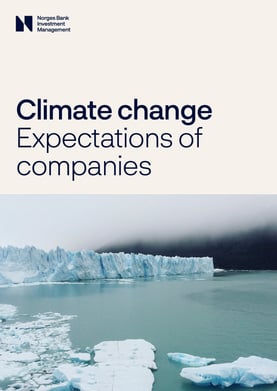Climate change

The financial materiality of climate change
Climate change will affect the global economy due to physical climate impacts, and transition risks, including regulatory change and the development of low carbon technologies. Global average temperatures have already increased more than 1.1°C above pre-industrial levels. The consequences are visible through extreme temperatures, drought, flooding and increased hurricane intensity. The near-linear relationship between cumulative CO2 emissions and global warming means that net zero emissions must be reached for global average temperatures to stabilise at any level. Losses worth up to 10 per cent of global GDP can be avoided by meeting the temperature objectives of the Paris Agreement. Subsidy-led investment is adding momentum to the technology shift from legacy products to low-carbon alternatives. This shift could add 2 to 5 trillion dollars to annual global energy system investments to 2050, which illustrates the financial opportunities from climate change.
Climate risks and opportunities are financially material and can already be observed across major asset classes, including equity, and corporate debt. The fund is exposed to climate risk and investment opportunities through the companies and assets it invests in. Companies increasingly face physical climate risk, of both acute and chronic nature, and a need for investments in adaptation and resilience. Companies also face transition risk and the need to reduce emissions from their operations and value chains. Such transition risks and opportunities may also give rise to changing demand for their products and services. The companies we invest in overwhelmingly operate in countries with national net zero commitments under the Paris Agreement, with legislative and policy frameworks in place to deliver them. In some markets, the commitments have been made legally binding through legislation. By adopting a net zero strategy, companies can demonstrate how they will be successful in a world with increasing climate risks, climate regulations and climate-related investment opportunities.
Our mandate establishes as a long-term goal for our responsible management activities that the operations of the companies we invest are compatible with global net zero emission in accordance with the Paris Agreement. On this basis, the ambition of our Climate Action Plan is for our portfolio companies to achieve net zero emissions by 2050. At the heart of the action plan are efforts to engage effectively with portfolio companies, using these expectations as a topic reference point. These engagement activities include company dialogues, filing and voting on shareholder proposals, and voting for or against the re-election of board members. In severe cases, companies which do not respond to engagement will be candidates for assessment under the climate-related conduct exclusion criterion. Our expectations also inform our investment analysis and risk management.

Core expectations
Our climate change expectations lay out how Norges Bank Investment Management believes companies should manage climate risks and opportunities. We have core expectations that apply to all companies. These are foundational, central to our board-level dialogues, and directly inform our voting and ownership activities.
Board oversight: Company boards should ensure climate risks and opportunities are integrated into corporate strategy and risk management. They should be transparent on how they establish oversight by disclosing details of the associated governance structures, mechanisms and activities involving the board.
Climate risk disclosures: Companies should analyse and disclose the way in which climate risk may impact their operations, value chains and demand for their products.
Greenhouse gas reporting: Companies should report scope 1, scope 2 and scope 3 greenhouse gas emissions in accordance with the Greenhouse Gas Protocol. Companies should seek reasonable assurance of at least their scope 1 and scope 2 emissions.
Net zero 2050: Companies should commit to net zero by 2050 or sooner and align their activities with the objectives of the Paris Agreement.
Interim targets: Companies should set science-based interim emission reduction targets that cover scope 1, scope 2 and material scope 3 emissions, consistent with net zero by 2050. Interim targets should be based on region- and industry-appropriate pathways, using the associated absolute or intensity measure for emissions.
Transition plans: Companies should implement time-bound and quantified transition plans, designed to deliver on their interim emission reduction targets, and annually disclose progress against pre-established and consistent KPIs.
Further direction
The next sections provide further direction on the good practices we encourage companies to adopt. They are based on established and emerging international standards for climate risk management and transition planning. We group them into four categories that broadly represent the order in which a company might develop its approach: foundations of corporate climate strategy; ambition and target setting; transition plans; and delivery and transparency.
Although most expectations apply to all companies in our portfolio, some are industry specific. We acknowledge that companies have different starting points and capabilities, and that approaches to decarbonisation will vary across regions and industries. In particular scope 3 emissions pose different industry-specific challenges and may require value chain solutions. Climate policy and regulatory frameworks also diverge globally and in aggregate do not yet support the delivery of global net zero. The ambition of companies therefore remains constrained by policy in some settings. Companies will need to balance efforts to manage climate risks and opportunities with generating sustainable financial returns if they are to ensure their long-term viability. We will consider such factors, as well as a company’s trajectory, or progress over time, when we engage with portfolio companies on our climate change expectations.

Foundations of corporate climate strategy
The starting point for integrating climate risks and opportunities into governance, strategy, risk management and disclosures.
The Paris Agreement: Companies should acknowledge the scientific consensus on climate change and endorse the objectives of the Paris Agreement.
Board oversight: Company boards should ensure climate risks and opportunities are integrated into corporate strategy and establish oversight of how this is delivered. Details of the associated governance structures, mechanisms and activities involving the board should be disclosed.
International Sustainability Standards Board (ISSB) reporting: Companies should analyse and disclose the way in which climate risk may impact their operations, value chains and demand for their products. At a minimum, disclosures should be aligned with IFRS S2 or equivalent standards. This approach builds on the recommendations of the Task Force on Climate-related Financial Disclosures (TCFD).
Greenhouse gas reporting: Companies should report scope 1, scope 2 and scope 3 greenhouse gas emissions in accordance with the Greenhouse Gas Protocol. Companies can increase transparency with disclosure via CDP or the Net-Zero Data Public Utility (NZDPU) in addition to corporate disclosures., Where relevant, companies should also report the physical emission intensity of their products.
Scope 2 methodologies: When reporting scope 2 emissions, companies should use the location method as a primary metric. Where companies also report their scope 2 emissions using the market method, they should reconcile the differences, including quantifying the use of energy attribute certificates such as unbundled renewable energy certificates (RECs).
Assurance: At a minimum, reported scope 1 and scope 2 emissions should be subject to reasonable assurance by a third party, and major underlying assumptions, including activity data and emissions factors, should be disclosed. Companies should seek limited assurance of their broader climate disclosures.
Scenario analysis: To analyse their resilience to a range of future outcomes, including those for 1.5°C and high physical damages, companies should use climate scenarios, and disclose the results. For companies in emission intensive sectors, scenario analysis should show how changes in climate policy, including carbon pricing, could impact their operations, value chains and demand for their products.
Adaptation and resilience: Companies should analyse and disclose how increasing physical climate risk could drive the need for investments in adaptation and resilience in their operations and value chains, including the long-term viability of assets. Companies with concentrated physical assets should disclose location data. Companies should explain whether their main adaptation needs are likely to be met by government investment.
Industry-specific expectations
Financed emissions: Financial services companies should report their financed emissions using the Partnership for Carbon Accounting Financials (PCAF) methodology.
Real estate emissions: Real estate companies should report operational carbon emissions from both landlord and tenant-controlled spaces, and embodied carbon emissions from developments.
Avoided emissions and lifecycle analysis: To demonstrate the emissions benefits of their products or services, companies are encouraged to use lifecycle emissions and avoided emissions analysis. Such disclosures should be made in addition to Greenhouse Gas Protocol reporting. The major assumptions underpinning the calculations should be disclosed.
Ambition and target setting
The scope, ambition and methodology for targets across industries and markets.
Net zero 2050: Companies should commit to net zero by 2050 or sooner and align their activities with the objectives of the Paris Agreement.
Interim targets: Consistent with net zero by 2050, companies should set science-based interim emission reduction targets that cover scope 1, scope 2, and material scope 3 emissions.
Scope 2 targets: Over time, companies should prioritise securing renewable power purchase agreements, or developing on-site renewable generation, ahead of using energy attribute certificates such as unbundled RECs.
Scope 3 targets: When setting scope 3 targets, companies should explain how they define the materiality of different scope 3 emissions categories. This should include considerations of how and where they can exert influence on their value chains and potential financial risks. Companies with combustion emissions in the use-phase of their products should specifically address scope 3 emissions in Use of Sold Products and Processing of Sold Products.
Net zero pathways: Emission reduction targets should be aligned with region- and industry-appropriate science-based pathways, using the associated absolute or intensity measure for emissions. Companies should disclose how they consider their target pathways to be Paris-aligned. Where industry appropriate guidance exists, companies are encouraged to submit their targets for validation by the Science Based Targets initiative (SBTi).
Industry-specific expectations
Product mix targets: Where demand for a company’s products or services is likely to be impacted by climate change, companies should incorporate product mix change into their target setting. An example would be an auto company setting a product mix target for zero emission vehicles.
Fossil fuel demand: For fossil fuel products, companies should plan for production that is consistent with climate science and expected demand-side changes. They should disclose reserve lives and remaining years of production based on current investment plans.
Methane emissions: Where methane emissions represent a material portion of a company’s overall greenhouse gas emissions, such as in agricultural or fossil fuel production, companies should set standalone targets for methane in line with the Global Methane Pledge.
Financed emissions: Companies in financial services should set standalone targets for the financed emissions associated with their lending, investing, capital markets and insurance activities. If financing coal activities, they should adopt policies for how this will be phased out, including criteria for providing new loan commitments or other financial intermediary support.
Real estate targets: Companies in real estate should set net zero emission reduction targets in line with the SBTi and Carbon Risk Real Estate Monitor (CRREM) energy-reduction pathways.
AFOLU: Companies with Agriculture, Forestry and Other Land Use (AFOLU) activities within their operations and value chains should seek to eliminate deforestation by 2025 and conversion of natural ecosystems in the short term, consistent with our expectation document on biodiversity and ecosystems. Companies should incorporate emerging international best practice for measurement and target setting, particularly frameworks such as the Taskforce on Nature-related Financial Disclosures (TNFD) and Science Based Targets Network (SBTN).

Transition plans
How a company will deliver on its climate ambition, with an emphasis on the prioritisation of near term action and the specific measures required to meet interim decarbonisation targets.
Decarbonisation strategy: Companies should implement and disclose time-bound and quantified decarbonisation strategies. Details should include specific abatement measures needed to reach their interim emission reduction targets, including internal abatement measures, divestments, output changes, carbon credits and contractual instruments such as RECs. Avoided emissions should not be included in a decarbonisation strategy. A sample disclosure is included in Appendix A.
Carbon credits: Companies can use carbon credits as a supplement to signal high climate ambitions but should follow the mitigation hierarchy and prioritise reducing GHG emissions from their own operations and value chains. The carbon credits should be additional and verified, with an increasing focus on durable removal credits over time. Companies should not count carbon credits towards science-based interim emission reduction targets and should disclose details of their use. We provide further details in our view on corporate use of voluntary carbon credits.
Carbon lock-in: To minimise the risk of carbon lock-in, companies should ensure that their interim targets and transition plans are consistent with the delivery of net zero 2050.
Abatement costs: When planning their decarbonisation strategy, emission-intensive companies should construct and analyse their abatement cost curve or a simplified equivalent to help quantify long-term decarbonisation costs beyond the interim target horizon.
Procurement: For internal abatement measures, companies should provide an overview of the products and service they plan to procure. If they rely on immature climate technologies to reach their interim targets, the use of advance market commitments, such as those under the First Movers Coalition, is encouraged.
Adaptation and resilience: Companies with concentrated physical assets or heightened physical climate risk in their value chains should include adaptation and resilience as part of their transition plan.
Financial planning: Companies should allocate adequate financial resources to their transition plan and disclose the associated capital expenditure and R&D expenditure. Decarbonisation capital expenditure guidance should include the total and annual amounts to the interim target year and the amounts allocated to each specific abatement measure.
Financial analysis: Companies should analyse and disclose expected changes to their financial model from their decarbonisation strategy including operating costs and capital structure.
Internal carbon pricing: To ensure their investment decisions are consistent with their emission reduction plans, companies should implement internal carbon pricing mechanisms.
Acquisitions and divestments: Companies should consider the climate implications of major acquisitions or divestments, in a way that prioritises the preservation of climate ambition.
Decarbonisation feasibility: For major emissions sources not included in a company’s decarbonisation strategy, companies should explain why they have chosen not to pursue them and the feasibility challenges acting as barriers to decarbonisation, including financial, technological, or policy hurdles.
Climate lobbying: Companies should align their lobbying activities with the objectives of the Paris Agreement and address membership of trade bodies or associations that is or may appear incongruent with the company’s climate change policy. Companies should be transparent about where they advocate for specific policy and legislative support.
Impacts and dependencies: Transition plans should consider impacts and dependencies with adjacent sustainability topics, such as the natural environment, workforces and impacted communities. Companies can refer to Norges Bank Investment Management’s expectations on human capital, human rights, and biodiversity and ecosystems for further details.
Stakeholder engagement: Companies should consider their current and planned engagement with peers, suppliers, customers and regulators, and how this supports their business and execution of their climate plan. Companies should also consider and mitigate the impacts of their transition plan on workers and affected communities.
Delivery and transparency
Mechanisms to ensure delivery of a transition plan, accountability, and transparency on progress.
Board accountability: Company boards should oversee the delivery of transition plans, considering the adequate use of financial and human resources. They should ensure that the internal delivery of the transition plan is compatible with the company’s public statements, targets and applicable regulatory regimes, to protect the company from litigation risk.
Decarbonisation KPIs: Companies should establish the KPIs that they plan to use on a consistent annual basis to measure progress in delivery of their transition plan. At a minimum this should include the annual and cumulative progress made towards emission reduction targets relative to the chosen baseline year.
Annual progress reporting: Companies should disclose progress annually on the delivery of their net zero strategy. This should cover pre-established decarbonisation KPIs, project and investment milestones in their transition plan, and planned developments for the coming year.
Strategy update cycle: To incorporate how their strategy might need to adjust for technology and policy changes, companies should undertake a net zero strategy review and update at least every three years.
M&A attribution: Companies should disclose the contribution that mergers and acquisitions have made to their reported emissions on a year-on-year basis. In the event of major mergers and acquisitions, reported emissions could be restated to adjust target baselines for emission reductions.
Remuneration: Companies should demonstrate how their remuneration and broader performance frameworks align with delivery of interim targets and transition plans. Where climate metrics are used in incentive schemes, they should be measurable, stretching and transparent, with a clear link to strategy.
Say On Climate: Where boards seek approval of their climate strategy through a Say On Climate vote, they should include detailed information on targets set and supporting plans that demonstrate the likelihood of delivery. Such votes do not supersede the board’s responsibility for ongoing oversight of climate change strategy. Annual votes are not necessary, unless a material change to the strategy is envisaged.
Pdf version
-
Climate change
Last saved: 15/09/2023
